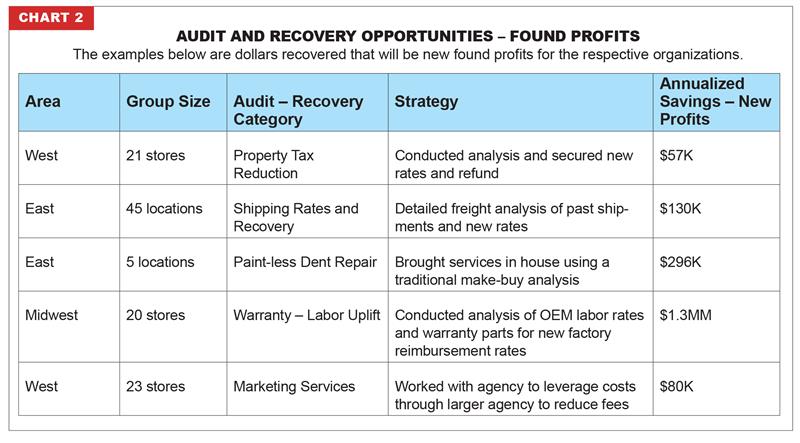By Doug Austin, Founder & President, StrategicSource, Inc.
My team and I just returned from a dealer-related trade show this week.The amount of companies offering new tools, solutions, and strategies designed to generate leads, increase loyalty of existing customers, track customers, and increase website visibility is simply mindboggling.
Dealers are certainly interested in the newest digital solutions, and anything to give them a leg up on their competition to drive new-top line revenue. What’s often challenging is determining which ones work and which do not. The one thing everyone agrees on, is that all of these new digital marketing solutions add expense to the operation and challenge profitability.
It is fair to say that many dealers are facing flat sales, declining profits, and increased expense pressures. According to NADA statistics, most new car dealers are earning between 2.5 and 3.0 percent net profits on their business. This a far cry from the profitability of years past, and according to dealers I have talked to, as well as industry news, it is increasingly difficult to generate the profit they earned just a few years ago.
Is it Possible to Increase Profitability by one percent?
The answer to the question above is yes. If management is willing to establish a cost reduction, centralization strategy and then hold their various locations accountable, they can see significant cost reductions and new profit. This fact alone does not include the new efficiencies that will occur across the organization from managing fewer suppliers.
We have modeled slight changes to expense categories across an organization for dealers over the years. Keep in mind the following:
Dealers will spend five percent of sales on supplies and services. $100MM in sales = $5MM in expense.
Dealers will spend that $5MM across up to 130 expense categories.
Centralization, quoting, and renegotiation will generate up to 25 percent of that $5MM in new profits.What would an additional $1.250MM do to your bottom-line net profits?
Would that move your net profit from 2.5 to 3.5 percent net profit or more?
Of course it would; The math works. Centralization works. That is why most companies across the U.S. landscape have centralized purchasing functions for years. For dealerships willing to take steps to manage more effectively, there are countless opportunities to reduce costs, improve profits, and recover supplier overcharges.
Expense Category Cost Reduction – New Profit Opportunities
Dealers source over 130 expense categories to keep their dealership(s) running. Quoting and negotiating with suppliers on a scheduled basis is always the best way to find the “truth” in the marketplace relative to pricing and costs. Below are some examples of supplies, services, and processes where pricing was successfully reduced and will generate new profits in the coming year. (See Chart 1)

Audit & Recovery Opportunities – Found Profits
Dealers pay fees for health insurance, utilities, DMS, taxes, etc. that are all subject to over-payments. Some suppliers charge for services that you may not have received. The examples on Chart 2 are dollars recovered and new-found profits for the respective organizations.

What Prevents Dealers from using a Centralization Strategy?
Why haven’t the majority of dealers across the country already centralized their purchasing or spend management functions? Why are they letting big dollars slip through the cracks and minimizing their own profitability?
There are numerous answers to this question that apply across all brands, all geography, and all sizes of groups, from single points to mega-groups.
1. GMs are incented on profits, so they are trusted to make the best supplier decisions.
2. Groups are reluctant to push GMs and locations to leverage fewer suppliers with better pricing because they don’t want to interfere with profitable operators.
3. Many dealers know they should centralize and adopt a new approach but feel they don’t have the time to do so with lean staffing levels.
4. If internal employees sense management is squishy about this centralization strategy, they will push back and find countless reasons to resist change and derail sensible changes that move the profit needle in a positive direction.
5. Some folks can’t admit they don’t know it all, or have all of the answers, and resist any meaningful purchasing changes. Pride stops many solutions dead in their tracks.
6. Some executives forget that the purpose of a corporation is to generate profits to sustain the business and feel the efforts to manage this process are too difficult and not worth their time.
We all work hard to run profitable businesses. For the life of me, I don’t understand how so many management teams continue to ignore the tried-and-true methods to drive new profits through more efficient and effective management through centralized purchasing. The obstacles outlined above are minor, and you can overcome them with the right management focus and the will to drive improved results.
Will You Improve Your Profitability?
There are lots of “shiny objects” out there, new products, and solutions designed to help you drive top-line sales and ultimately improve your profitability. To remain competitive, you have to keep up with new technology and explore those solutions that work. But, being the multi-talented executive that you are, it is possible to pursue two strategies at once… drive top-line sales to new levels and also drive bottom-line profits with more effective and efficient processes and strategies.
What would your organization do with another one percent in net profits?
- Increase your compensation? Compensation for your team?
- Finance upgrades to your property?
- Invest the proceeds?
- Invest in new equipment?
You don’t need another one percent in net profits? Well, continue on with your current decentralized approach, and your suppliers will happily earn stronger net profits thanks to you.
Verify potential net profit
What is one percent of your 2018 net profits? Can you obtain that dollar amount through more efficient, better leveraged purchasing performance? I am willing to bet that it will move the needle by one percent or more.
Is it worth the effort? Only you can answer that question. Are you serious enough to manage through the minor obstacles that will occur along the way? If so, you are on your way to a more profitable year.
About the Author
Doug Austin is the founder and president of StrategicSource, Inc., the leading provider of spend management services for the automotive and truck dealerships, and various other vertical markets. Doug is a veteran of the U.S. Marine Corps, a graduate of the University of St. Thomas, and a speaker at various conferences, 20 Groups, seminars and webinars. Doug has acquired 30+ years of line, staff, and executive experience in spend management and supply chain management in various vertical markets.







